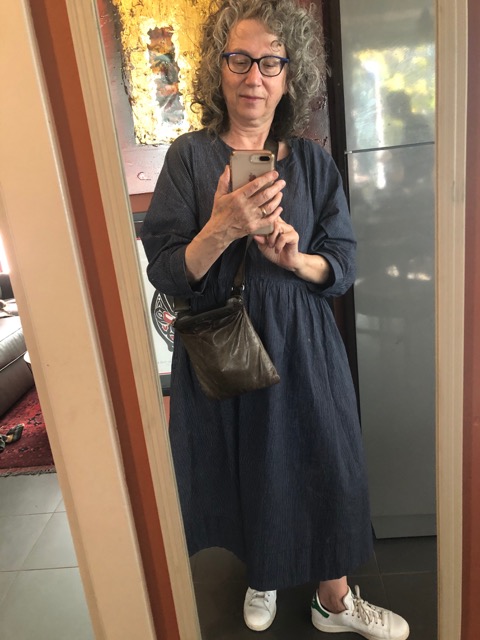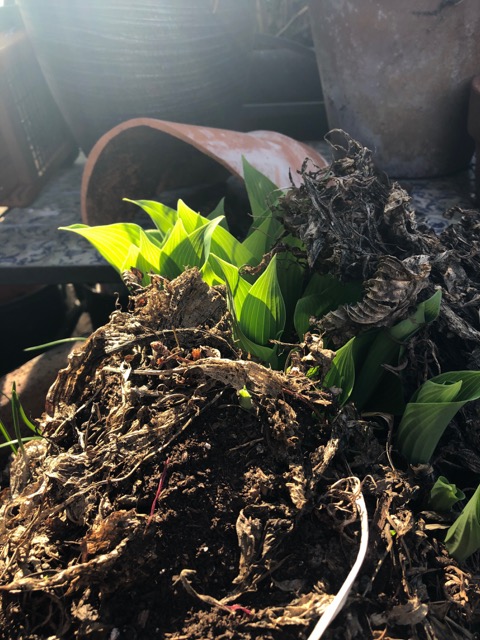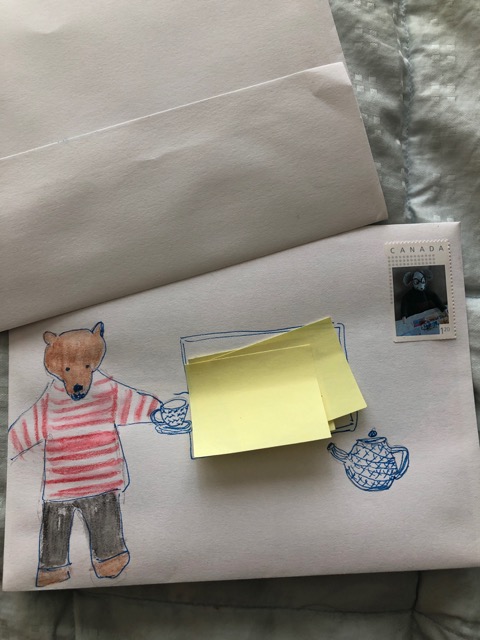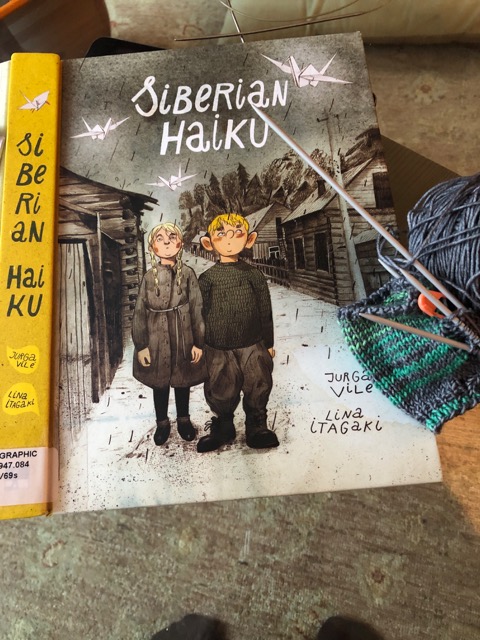If you’re not spending all your time in the garden these Spring days (or raking up leaves and chopping firewood, if you’re in the other hemisphere), today’s post comprises my report on the books I read in March, and you might find a title or two for your To Be Read lists. . .
But before I share that report with you, because it’s the duplicate of a post some of you may already have seen last week on my book blog, Materfamilias Reads, I’m including a few Non-book photos for a bit of “added value.” When I posted my January reading here,in early February, the “value added” consisted of taking you for a virtual walk in the snow. I’m glad to say that we won’t be doing that today!

Instead, here’s a Selfie I took in the mirror last week before heading out on my afternoon walk — without a sweater, never mind a jacket. Also missing? tights!! And I’m wearing a favourite dress, bought on sale at the end of last summer — in a different city, when we could still travel a bit. That was the last time I hugged a Five and a Two, who have since become a Six and a Three. . . Sigh. . .
If you look carefully in the photo above, you can see my fellow’s reflection — from the doorway to the garden terrace. . . We’ve been spending hours out there planting and pruning and tidying up . . . and sitting and reading and sipping tea, eating breakfasts, lunches, dinners. Such an expansive season, is Spring, so much optimism in the sunshine. . .
I have SO many garden photos I could show you, but this will already be a long post. . . Perhaps I’ll publish a second one this week just to take you ’round the various blooms and shoots.

But I really thought that my photo of these hosta leaves finally pushing aside the covering of leaf mulch to stretch into the morning sunshine captured Spring’s renewal and optimism.
My last photo before I get to the books is a shot of the envelope I sent off to a Big Sister and Little Brother this week with one of my handmade Teddy Bear Tea Party cards inside. Funny to think that a decade ago I would have been absolutely sure that I could not draw a decent teddy bear nor add a teacup and teapot for him to pour and drink from. This old dog has learned a trick or two. . . 😉

And there ends the supplemental material to my Book post. If you’re looking for reading recommendations, I hope you’ll find something that appeals in my account of Books I Read in March.
March Reading:
17. Siberian Haiku Jurge Vile; Illustrator, Lina Itagaki; Translator, Jura Avizienis. Graphic novel; Autofiction; historical fiction; YA/children’s literature;
18. The Alice Network, Kate Quinn. Historical fiction; Spy novel; romance; strong female protagonist; WWII
19. The Midnight Library, Matt Haig. Speculative fiction; sci-fi; philosophical fiction; depression/suicide; possibilities of life
20. The Wild Silence, Raynor Wynn. Memoir; Writing; Adventure; Outdoor Life; Illness; Spouse with Illness; Environmental Writing; Iceland; Hiking
21. White Ivy, Susie Yang, Contemporary fiction; thriller; romance; immigrant narrative; class/ethnicity/gender; American society
22. The Invisible Life of Addie LaRue, V.E. Schwab, Fantasy; Gothic; romance; historical fiction
23. Il n’est jamais trop tard pour éclore: Carnet d’une Late Bloomer, Catherine Taret. Memoir; self-help
24. The Searcher, Tara French. Mystery/thriller; Set in rural Ireland
25. Nervous Conditions, Tsitsi Dangarembga. Literary fiction; bildungsroman (coming-of-age); adolescent girl; (post-) colonialism; Africa; Zimbabwe; education
26. Unto Us a Son Is Given, Donna Leon. Mystery; set in Venice, Commissario Brunetti series
The first book in my March reading list was a serendipitous choice of a book I’d never heard of before, simply because the cover caught my eye from the New Books shelf at the neighbourhood branch of Vancouver Public Library. I regularly tell myself that I should read more (some!) graphic novels, and this one’s cover illustration and its title (Haiku? in Siberia? how? why?) intrigued me

My Reading Journal entry for this book begins at the bottom of the photographed page . . .

It may be that the target audience for the story of a family’s WWII deportation from Lithuania to Siberia is children and young adults, say from 11 or 12 years and older, but I was engaged and moved and entertained and informed in so many ways throughout. Despite the bleak historical content, the writing and images collaboratively construct a story full of warmth and humour, hope and joy, while never shirking the responsibility of witnessing the deprivation and insults and horrors experienced.


My Instagram post for this book includes a few more favourite pages.
Highly recommended, both for you and, perhaps, your children or grandchildren or young friends of an age mature enough to cope with the realities depicted.
The next book I read, Kate Quinn’s The Alice Network, was also historical fiction, also set during World War II . . .
As I wrote in my Reading Journal, I’ve long been wary of fiction that draws on war as a background for its narrative. This novel didn’t overcome that reservation, as you can read below, but I nonetheless found some merit in it, particularly in the strong female characters who defied social conventions for women of their day.


The 19th title of my year’s reading was Matt Haig’s The Midnight Library. Tough to assign genre to this one with its mixture of philosophy, quantum physics, a Borgesian library and a suicidally depressed young woman wondering what it might mean to live a happy life.
There were a few points when I was on the verge of thinking it might become tiresome, overly tendentious, but instead I found it, overall, suprisingly charming, restorative even.
Posted about it on Instagram as well.
And I think I’d read it all again, simply for this page. . .

Raynor Winn’s The Wild Silence, is a book I bought — in hardcover yet! — on the strength of Winn’s first book, the marvellous The Salt Path. I’ve heard from other readers who were disappointed by her second title, so I suppose I began reading with lowered expectations.
And although I read the first few chapters waiting to catch Winn’s rhythm, to see where she was taking us this time, I was soon enough caught up in the memoir — which turns out to be as much prequel as follow-up to The Salt Path (something of a “the making/writing of”). She recounts the process of deciding what she might do after the grand adventure of walking the path ’round England’s southwest coast. At that point, she and Moth, her terminally ill husband, had only a temporary home and little idea what the future would hold, beyond Moth trying to complete a teaching degree at the local university. Tentatively, Ray begins to write and in so doing, confronts her shyness, tracing some of it back to her childhood and recognizing as she does so the strength she’d always drawn from nature and from books. And she traces the long arc of her still-passionate love affair with a man whose strength she sees diminish daily.
I won’t tell you anymore, except to say that if beautifully observant, lyrical environmental writing appeals to you as much as narratives about women in their 50s realizing their strength and transforming their lives, add this one to your list. Oh, and if you want a bit of adventure as well? What about a strenuous back-packing hike through Iceland by a couple in their 50s, one of whom has a terminal, degenerative, neurological illness? Or the restoration of a dilapidated old farmouse, cider mill and apple orchard?

I put Susie Yang’s White Ivy on hold at my library after seeing it recommended as a thriller; I have to say that it’s so much more than this. Or perhaps, more fairly, it stretches the possibilities of what “a thriller” can be or do — this novel also explores identity and intersectionality (race, gender, class, ethnicity) and immigration and American society! Very impressive debut, and I’ll be watching for other titles from this author (who, at 32, already has a doctorate in pharmacy and a tech start-up on her CV — author interview here.)
I think I learned about V.E. Schwab’s The Invisible Life of Addie LaRue on my niece’s Instagram account, Pages_and_Pinots. I’d say this is not a genre I usually read, but in the last year (blame or credit a certain pandemic!), I’ve read and enjoyed books by Jess Kidd and Alice Hoffman and Erin Morgenstern. And I enjoyed Addie LaRue very much as well; perhaps it’s a bit bloated, but most readers will want every page of the 300-year-old Addie’s life. A gripping and indulgent novel to hunker down with next rainy day or take to your favourite hammock on a sunny one.
See my Instagram post for an example of the many felicitous metaphors in this novel.

Catherine Taret’s self-help memoir Il n’est jamais trop tard pour éclore: Carnet d’une late bloomer was on my list as a way to practise my French, and it did that. But if I’d picked up It’s Never Too Late to Hatch: A Late Bloomer’s Notebook in English, I probably wouldn’t have read beyond the first chapter. I’m not the target audience, but if you’re well-educated, white, bourgeois, 30s/40s, attractive and serially monogamous with sufficient funds for extensive therapy and self-help workshops, and frustrated that you haven’t figured out what you want to be yet. . . .
I don’t need to tell you, do I, that Tana French’s mystery novels are always very good? If you don’t know them, you might want to begin with her Dublin murder squad books, but The Searcher (a stand-alone set in rural Dublin) could also be a good introduction.
See my Instagram post for a favourite passage and for other readers’ comments about this book.

The 25th novel I read this year will probably feature in my Top Five for 2021. Tsitsi Dangarembga’s Nervous Conditions was first published in 1988, and is regularly acclaimed as an important book in the African literary canon. If you’re looking for novels that will deepen your knowledge and understanding of post-colonial Africa and particularly of African women’s lives, this coming-of-age story set in late 60s rural Zimbabwe provides a complex, nuanced, and compelling narrative that challenges and subverts stereotypes.
My Instagram posts here and here

Highly recommended, and I’m currently reading Dangarembga’s Booker-nominated The Mournable Body which brings these characters back some twenty years later. But I’ll tell you about that next month. For now, I need to focus on finishing this post before April’s half done (I have one more day!).

Last March entry in my Reading Journal is Donna Leon’s Unto Us a Son Is Given, the 28th volume in her Commissario Brunetti series. I posted a too-close-for-comfort passage on Instagram.
And that’s it for this month. . . . at least, that’s it for my reading, but what about yours? Can we talk books? Share titles? Compare responses? Have you read any of the books I’ve mentioned here? Agree or disagree with what I’ve written? Have “reads well with” suggestions? All comments welcome (well, unless you’re going to tell me about bargain sunglasses or some magical medical aid or such. Those will only be deleted).
The illustrations in Siberian Haiku are gorgeous (I covet it but I'm trying not to buy things to keep my life streamlined); the page from The Midnight Library is moving, and makes me want to read the book; Tana French is a favorite author, whose books I've been re-reading/reading recently after a Kate Atkinson phase with a Meg Wolitzer, Laura Zigman, and Lorrie Moore added to the mix; and poetry, always poetry. x.
I do like the sound of a ‘ garden terrace ‘ . Are the logistics difficult , for instance soil removal & watering ? or now you have it straight is there very little of that ? I’m curious . My latest read was The Disappearance of Lydia Harvey by Julia Laite . The true story of a very young New Zealand girl in what was then called the white slave trade of the early 20 century . Not written in a sensationalistic way but well researched & very readable . You might like it .
Wendy in York
Just finished "Between Two Kingdoms" by Suleika Jaouad. She is a young woman who wrote a byline/blog for The New York Times around 2012 called Life, Interrupted chronicling her cancer journey, which I remember following at the time. She is a gifted writer. Her life was interrupted by a particularly virulent cancer at the age of 22 that devastated her life and body. The book is about her journey–the before and the after and the in-between of what it means to face death before one really has a chance to face life. The lessons learned. The mental journey often as difficult as the truly harrowing physical one she experienced over the course of years. Coming to terms with what it means to survive when so many others she met along the way did not. A poignant, thoughtful and moving read.
It is about bargain sunglasses. Please don't delete me!
You stirred a memory…Every, Single. Time. I have travelled with my daughter she has bought sunglasses (sometimes bargain, sometimes not, depending on how flush she is at the time) and I am required to watch her try them on and give opinions ie offer praise for the pair she likes best and criticize the others. As I read your words I could feel my face getting into position to do that. Including trying to hold my eyes still while they flick around in search of the exit. Ah the things we do.
(Reading yes, but nothing noteworthy. Lots of poetry as mentioned by another commenter. Something in that but need to think it through a bit more.)
Katherine: I know what you mean. I've been trying to control the coveting and the acquiring — luckily, I only live a block from the library ;-). . . Ah, Lorrie Moore, her story "People like that are the only people here." So good, so painful.
Wendy: Good questions! We're lucky that there's a water tap on the terrace — we just have to be careful to bleed and shut all off before serious frost. I'm glad Paul is fit and strong and seems not to mind getting his exercise hauling soil and planting pots up and bringing the (wheeled) bin of garden clippings down. And then last summer, we got a rotating compost bin, tucked discreetly away, so we've been augmenting some of the soil that way. . . Your book sounds fascinating — and I suspect Mary (next commenter) might be interested in it as well, as I believe she enjoys a good memoir.
Mary: See above, my comment to Mary; her last book read might interest you. The two by Suleika Jaouad you describe must have been tough to write, and to read. Thanks for your compelling recommendation.
Georgia: That's so funny! It reminded me of going jean-shopping with my daughters when they were in their teens and even into their twenties — I mostly just saw jeans, whereas they were emphatically discerning — or discerningly emphatic? Poetry is such a solace for its ability to engage us with only a few lines, if that's all we have time or inclination for. And those few lines, well chosen, can hold all that we might distill and retain from hundreds of lines of prose….
Love this dress!
I-am-so-jealous (and feel cheated about what we have learned in school about Canada): no tights,roof garden in full bloom…..we are freezing! First pots with flowers only this week on my balcony…..
About books,as always,on Materreads….
Dottoressa
Dottoressa: Ha! There was fresh snow in many cities across Canada this week, but we are very fortunate here on the southwest coast . . . I'm sure your balcony flowers will be lovely. Did you get out to the orchard? Any blooms there?
I am watching this garden come to life – it is full of surprises. Right now there are tulips of various colours and petal shapes coming up. Not in full bloom yet, because we are quite a bit behind this year. April has been very cold.
I haven't had much time for reading lately, and most of the books I did read were in German anyway. But I should like to recommend Thomas Mullen's "Darktown", a mystery set in the city of Atlanta in 1948. The protagonists are two members of the first unit of Black policemen established there. The descriptions of the pervasive racism and violence are hard stuff, but very illuminative.
Eleonore: How good that you're finding some delights in this new garden! I'm sure you'll quickly find time to make it your own. I'll put in a request at the library for Darktown, thanks!